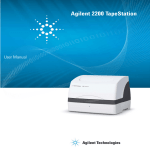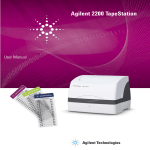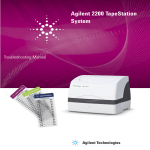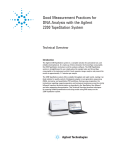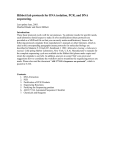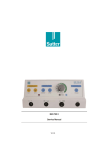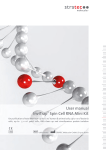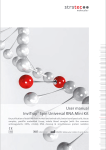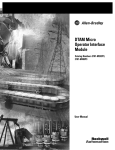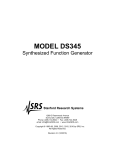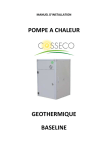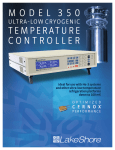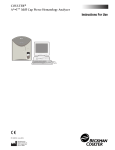Download Agilent 2200 TapeStation
Transcript
Agilent 2200 TapeStation User Manual Agilent Technologies Notices © Agilent Technologies, Inc. 2011, 2012 Warranty No part of this manual may be reproduced in any form or by any means (including electronic storage and retrieval or translation into a foreign language) without prior agreement and written consent from Agilent Technologies, Inc. as governed by United States and international copyright laws. The material contained in this document is provided “as is,” and is subject to being changed, without notice, in future editions. Further, to the maximum extent permitted by applicable law, Agilent disclaims all warranties, either express or implied, with regard to this manual and any information contained herein, including but not limited to the implied warranties of merchantability and fitness for a particular purpose. Agilent shall not be liable for errors or for incidental or consequential damages in connection with the furnishing, use, or performance of this document or of any information contained herein. Should Agilent and the user have a separate written agreement with warranty terms covering the material in this document that conflict with these terms, the warranty terms in the separate agreement shall control. Manual Part Number G2964-90000 Edition 03/2012 Printed in Germany Agilent Technologies Hewlett-Packard-Strasse 8 76337 Waldbronn This product may be used as a component of an in vitro diagnostic system if the system is registered with the appropriate authorities and complies with the relevant regulations. Otherwise, it is intended only for general laboratory use. receive no greater than Restricted Rights as defined in FAR 52.227-19(c)(1-2) (June 1987). U.S. Government users will receive no greater than Limited Rights as defined in FAR 52.227-14 (June 1987) or DFAR 252.227-7015 (b)(2) (November 1995), as applicable in any technical data. Safety Notices CAUTION A CAUTION notice denotes a hazard. It calls attention to an operating procedure, practice, or the like that, if not correctly performed or adhered to, could result in damage to the product or loss of important data. Do not proceed beyond a CAUTION notice until the indicated conditions are fully understood and met. Technology Licenses The hardware and/or software described in this document are furnished under a license and may be used or copied only in accordance with the terms of such license. Restricted Rights Legend If software is for use in the performance of a U.S. Government prime contract or subcontract, Software is delivered and licensed as “Commercial computer software” as defined in DFAR 252.227-7014 (June 1995), or as a “commercial item” as defined in FAR 2.101(a) or as “Restricted computer software” as defined in FAR 52.227-19 (June 1987) or any equivalent agency regulation or contract clause. Use, duplication or disclosure of Software is subject to Agilent Technologies’ standard commercial license terms, and non-DOD Departments and Agencies of the U.S. Government will WA R N I N G A WARNING notice denotes a hazard. It calls attention to an operating procedure, practice, or the like that, if not correctly performed or adhered to, could result in personal injury or death. Do not proceed beyond a WARNING notice until the indicated conditions are fully understood and met. Agilent 2200 TapeStation - User Manual Contents Contents 1 Introduction to the 2200 TapeStation System Overview of the System 2 Specifications 5 6 11 Technical Specifications 12 ScreenTape Specifications 13 3 Installing the System 17 Unpacking the System 18 Contents of the ScreenTape System Installing the System 23 20 4 Using the 2200 TapeStation System 27 Intended Use of the 2200 TapeStation System 28 Performance Limitations of Use 29 Additional Components Required by the User 30 Operating Procedure 31 5 Maintenance 53 General Information 54 Changing the Needle 55 6 Appendix 57 Limited Use Label License 58 Sound Emission 59 The Waste Electrical and Electronic Equipment Directive Technical Service 61 Agilent 2200 TapeStation - User Manual 60 3 Contents 4 Agilent 2200 TapeStation - User Manual Agilent 2200 TapeStation - User Manual 1 Introduction to the 2200 TapeStation System Overview of the System 6 ScreenTape Architecture 7 Agilent 2200 TapeStation Components 8 This chapter gives an introduction to the system Agilent Technologies 5 1 Introduction to the 2200 TapeStation System Overview of the System Overview of the System The Agilent 2200 TapeStation system is a revolutionary tape-based platform for simpler, faster and more reliable electrophoresis. It is made up of three elements: a consumable tape (ScreenTape), an instrument (the 2200 TapeStation) and an analysis software. The system is very straightforward to use, simply place the sample tubes and ScreenTape in to the 2200 TapeStation and let it load, separate, image, analyse and present the results. Place ScreenTape and some tips in the 2200 TapeStation. Place your samples in the 2200 TapeStation and click Start on the controller software. View your analysed results in around 1 min per sample. This User Manual guides the operation of ScreenTape, the 2200 TapeStation and software for the analysis. The contents of the ScreenTape System are detailed below. Information pertaining to the 2200 TapeStation can be found in: • 2200 TapeStation Technical Specification • 2200 TapeStation Components 6 Agilent 2200 TapeStation - User Manual Introduction to the 2200 TapeStation System Overview of the System 1 • Installing the 2200 TapeStation Information pertaining to sample and ScreenTape requirements can be found in: • ScreenTape Architecture • Operating Procedure ScreenTape Architecture Barcode: The unique barcode tracks lane usage within individual ScreenTape and allows traceability of results. Buffer chamber: The buffer chamber is located at the top of the channel and contains optimised buffers for the effective separation of nucleic acid fragments or proteins. Electrodes: The integrated electrodes apply a current across the ScreenTape and eliminate the need for any additional electrophoresis equipment. Gel: The acrylamide-based gel contained within ScreenTape has been developed specifically to resolve nucleic acids or proteins. ScreenTape product details: The information is unique to each consumable item. This includes: ScreenTape type, product expiry date and a unique serial number. Figure 1 Example: P200 ScreenTape Agilent 2200 TapeStation - User Manual 7 1 Introduction to the 2200 TapeStation System Overview of the System Agilent 2200 TapeStation Components 8 Lid: The 2200 TapeStation lid must be closed each time the instrument controller software is opened, and whilst the instrument is in operation. LED: The LED will illuminate once the instrument is on. When the LED is flashing slowly, the instrument is in use and the lid should not be opened, rapid flashing indicates that the TapeStation requires some attention. Sample Block: There are 2 sample blocks provided that can either hold 0.2 mL tubes or a 96 well plate. Tip Holder: The tip holder can accommodate up to 16 TapeStation loading tips at any one time. ScreenTape: The tape must be placed into the holder with the barcode towards the front of the instrument, facing towards the right. USB Socket: The USB connector is inserted into the USB socket to link the laptop to the 2200 TapeStation. Power-cable socket: The power cable must be connected to the 2200 TapeStation and the relevant mains electricity outlet. Agilent 2200 TapeStation - User Manual Introduction to the 2200 TapeStation System Overview of the System 1 Lid ScreenTape Tip holder Sample block LED Figure 2 2200 TapeStation (front view) Figure 3 2200 TapeStation (back view) On/off switch Power-cable socket USB socket Agilent 2200 TapeStation - User Manual 9 1 10 Introduction to the 2200 TapeStation System Overview of the System Agilent 2200 TapeStation - User Manual Agilent 2200 TapeStation - User Manual 2 Specifications Technical Specifications ScreenTape Specifications 12 13 This chapter provides information on specifications. Agilent Technologies 11 2 Specifications Technical Specifications Technical Specifications 2200 TapeStation Input voltage: 12 V DC Power consumption: 40 W (VA) Current: 3A Interface: USB cable (PC comms.) Instrument Housing: UL94/VO rated flame retardant cast polyurethane Dimensions: 400 x 310 x 310 mm Weight: 12.5 kg Power Supply Input voltage: 100 – 240 V AC Input frequency: 50 – 60 Hz Phase: 1 Current: 0.45 – 1.1 A Environmental condition 12 Optimal operating temperature 23 °C (73.4 °F). Ambient operating temperature 10 – 37 °C (50 – 98.6 °F) for DNA applications 10 – 33 °C (50 – 91.4 °F) for RNA and Protein applications Agilent 2200 TapeStation - User Manual Specifications ScreenTape Specifications 2 ScreenTape Specifications Specification (High Sensitivity D1K ScreenTape and D1K ScreenTape) Analytical Specification High Sensitivity D1K ScreenTape D1K ScreenTape Sizing Range 35 – 1000 bp 35 – 1000 bp Resolution1 35 – 300 bp: 15 %, 300 – 1000 bp: 10 % 35 – 300 bp: 15 %, 300 – 1000 bp: 10 % Sensitivity2 5 pg/µL3 0.05 ng/µL Sizing Precision 5 % CV 5 % CV Sizing Accuracy4 ±10 % ±10 % Quantitative Precision 15 % CV 10 % CV Quantitative Accuracy ±20 % ±20 % Quantitative Range 75 – 1000 pg/µL 0.1 – 50 ng/µL Carry Over N/A N/A Analysis Time 16 samples < 20 min, 96 samples < 100 min 16 samples < 20 min, 96 samples < 100 min Samples per consumable 16 16 Sample Volume Required 2 µL 1 µL Shelf Life 4 months 4 months Box/Kit size 112 samples/box 112 samples/box Physical Specification 1 Resolution is defined as the separation of fragments at half peak height or better 2 signal:noise ratio > 3 for single peak 3 2200 TapeStation Nucleic Acid System (G2965AA) 4 Determined using the D1K ladder as sample Agilent 2200 TapeStation - User Manual 13 2 Specifications ScreenTape Specifications Specification (High Sensitivity R6K ScreenTape and R6K ScreenTape) Analytical Specification High Sensitivity R6K ScreenTape R6K ScreenTape Quality Score RINe RINe Sensitivity 100 pg/µL 2 ng/µL Quantitative Precision1 20 % CV 15 % CV Qualitative Range 100 – 10000 pg/µL 2 – 500 ng/µL Analysis Time 16 samples < 15 min, 96 samples ~ 100 min 16 samples < 20 min, 96 samples ~ 100 min Samples per consumable 16 16 Sample Volume Required 2 µL 1 µL Shelf Life 4 months 4 months ScreenTape box size 112 samples/box 112 samples/box Physical Specification 1 14 Within a ScreenTape Agilent 2200 TapeStation - User Manual Specifications ScreenTape Specifications 2 Specification (P200 ScreenTape) Analytical Specification P200 ScreenTape Sizing range 10 – 200 kDa Resolution1 15 % Typical Sizing Accuracy ±10 % (CAII, Lysozyme, beta lactoglobulin) Sizing Precision 3 % CV Quantitative Range/precision 100 – 1000 ng/µL for IgG; 15 % CV Qualitative Range 5 – 5000 ng/µL BSA, Lysozyme; 12.5 – 5000 ng/µL IgG Sensitivity2 5 ng/µL Lysozyme; 12.5 ng/µL IgG Physical Specification Sample volume needed 2 µL Analysis Time 16 samples <15 min Samples/consumable 16 Kit Size 112 Samples Kit Stability 4 months 1 for ladder 2 signal :noise ratio > 3 Agilent 2200 TapeStation - User Manual 15 2 16 Specifications ScreenTape Specifications Agilent 2200 TapeStation - User Manual Agilent 2200 TapeStation - User Manual 3 Installing the System Unpacking the System 18 Contents of the ScreenTape System 20 Installing the System 23 Software Installation 23 Agilent 2200 TapeStation Set Up 24 This chapter gives information about how to install the system. Agilent Technologies 17 3 Installing the System Unpacking the System Unpacking the System Unpacking the Agilent 2200 TapeStation Do not attempt to unpack the 2200 TapeStation instrument until you have read the accompanying Site and Safety Manual. CAUTION Condensation within the instrument Condensation will damage the system electronics. ➔ If your instrument was shipped in cold weather, leave it in its box and allow it to warm slowly to room temperature to avoid condensation. CAUTION "Defective on arrival" problems If there are signs of damage, please do not attempt to install the instrument. Inspection by Agilent is required to evaluate if the instrument is in good working condition. ➔ Notify your Agilent sales and service office about the damage. ➔ An Agilent service representative will inspect the instrument at your site and initiate appropriate actions. WA R N I N G Personal injury The TapeStation is heavy. ➔ Enlist the aid of a co-worker to share the lifting load to avoid personal injury. 1 Remove the TapeStation from the packaging and place on a clean, dry, flat surface. 2 Allow the TapeStation to acclimatise to the ambient temperature of the operating environment. 18 Agilent 2200 TapeStation - User Manual Installing the System Unpacking the System 3 3 Remove the label covering the tape holder, as shown in the image below. Figure 4 Remove before use Delivery Checklist Ensure all parts and materials have been delivered with your system. The delivery checklist is shown below. Please report any missing or damaged parts to your local Agilent Technologies sales and service office. Agilent 2200 TapeStation - User Manual 19 3 Installing the System Contents of the ScreenTape System Contents of the ScreenTape System The Agilent 2200 TapeStation Table 1 The Agilent 2200 TapeStation System (G2964AA, G2965AA) Product Volume Properties Agilent 2200 TapeStation 1x Instrument for loading, electrophoresing, imaging and analysing: • 2200 TapeStation System (p/n G2964AA) or • 2200 TapeStation Nucleic Acid System (p/n G2965AA) TapeStation Software Setup Disc 1 x CD The software is required to drive the 2200 TapeStation and visualise the ScreenTape analysis Laptop 1 x Laptop Instrument Control Laptop USB Cables/Power supply units 1 x USB cable 2 x power cords 1 x USB cable to connect the laptop to the TapeStation 1 x Power supply unit for the laptop 1 x Power supply unit for the TapeStation Sample Block 1 x 0.2 mL strip and 1 x 96 well plate A removable sample block for the correct loading of samples within the TapeStation Tip Holder 2x A removable cartridge for pipette tips placed in the TapeStation TapeStation loading tips 1 x 384 tips Pipette tips to use in the 2200 TapeStation TapeStation compatible 0.2 mL tube strips and lids 1x box of 120 tubes and caps Tube strips for placing samples mixed with loading buffer into the 2200 TapeStation 96 well plates pack of 10 96 well plate foil seal pack of 100 Loading tip transfer tool (optional) 1x Guides 20 Site Safety guide and Quick Guides (G2964AA - Protein, DNA and RNA; G2965AA - DNA and RNA) Agilent 2200 TapeStation - User Manual Installing the System Contents of the ScreenTape System 3 ScreenTape Products Products for analysing dsDNA High Sensitivity ScreenTape D1K and Reagents 5067-5363 High Sensitivity ScreenTape D1K 7 ScreenTape 5067-5364 High Sensitivity D1K Reagents • High Sensitivity D1K Ladder • High Sensitivity D1K Sample Buffer 1 vial 75 µL 360 µL ScreenTape D1K and Reagents 5067-5361 ScreenTape D1K 7 ScreenTape 5067-5362 D1K Reagents • D1K Ladder • D1K Sample Buffer 1 vial 75 µL 360 µL Products for analysing RNA High Sensitivity ScreenTape R6K and Reagents 5067-5369 High Sensitivity ScreenTape R6K 7 ScreenTape 5067-5370 High Sensitivity R6K Reagents • High Sensitivity R6K Sample Buffer 1 vial/bag 300 µL ScreenTape R6K and Reagents 5067-5367 ScreenTape R6K 7 ScreenTape 5067-5368 R6K Reagents • R6K Sample Buffer 1 vial/bag 500 µL Agilent 2200 TapeStation - User Manual 21 3 Installing the System Contents of the ScreenTape System Products for analysing Proteins ScreenTape P200 and Reagents 5067-5371 P200 ScreenTape 7 ScreenTape 5067-5372 P200 Reagents • P200 5X Labeling Dye • P200 Labeling Buffer • P200 Reducing Sample Buffer • P200 pH Buffer • P200 Non-Reducing Sample Buffer • P200 Markers (pre-stained) • P200 Ladder 70 µL 350 µL 550 µL 1000 µL 550 µL 270 µL 40 µL 22 clear Agilent 2200 TapeStation - User Manual 3 Installing the System Installing the System Installing the System Software Installation The software for your Agilent 2200 TapeStation system is preinstalled on the system laptop. NOTE For updates, or if you have to change the laptop, you may download the latest version of the software from the update server http://www.agilent.com/genomics/tapestation. For details on installation of the software refer to the readme.txt file on the installation CD Agilent 2200 TapeStation Software TAPESTATION INSTRUMENT CONTROL AND DATA ANALYSIS. Agilent 2200 TapeStation - User Manual 23 3 Installing the System Installing the System Agilent 2200 TapeStation Set Up Hardware required Laptop Software required Agilent 2200 TapeStation Software (already installed) WA R N I N G Personal injury, explosion or fire ➔ Do not operate the instrument in an atmosphere containing explosive gases or near flammable volatile liquids. ➔ Only approved supplied mains cord set must be used with this instrument and if an extension lead is required, the lead must be earthed. ➔ If the equipment is used in a manner not specified by the manufacturer, the protection provided by the equipment may be impaired. NOTE For general safety information, please refer to the 2200 TapeStation System - Site and Safety Manual. 1 Connect the supplied USB cable between the port on the back of the instrument and your laptop. 2 Power the instrument with the supplied power lead and adaptor. 3 Turn the instrument on using the power switch located at the back of the TapeStation. When powered and idle, the instrument will have a blue LED visible on the front of the case. 4 Windows may display a Found New Hardware wizard once the software has loaded. In this instance, always perform the following steps: a Select No, not this time to prevent connecting to Windows Update and searching for software. b In the next window select Install the Software automatically. c If a window appears, indicating the software did not pass the windows logo testing, click Continue Anyway. A window appears, indicating that the hardware has been successfully installed. The TapeStation system will function. 24 Agilent 2200 TapeStation - User Manual Installing the System Installing the System NOTE 3 As there is more than one driver that can be detected and installed, you may need to follow these steps more than once. You may need to follow these steps if you change the USB port on the laptop for the TapeStation connector cable. Agilent 2200 TapeStation - User Manual 25 3 26 Installing the System Installing the System Agilent 2200 TapeStation - User Manual Agilent 2200 TapeStation - User Manual 4 Using the 2200 TapeStation System Intended Use of the 2200 TapeStation System Performance Limitations of Use 28 29 Additional Components Required by the User 30 Operating Procedure 31 How to prepare your samples 31 DNA Sample Preparation 33 RNA Sample Preparation 35 Protein Sample Preparation 39 Using the TapeStation Software 42 Add Experiment Notes 46 Describe Samples 47 Start the TapeStation 48 Final Check 48 Run Further 49 Abort the TapeStation 50 Complete TapeStation 51 Empty Tip Buckets 51 How to Use the Agilent TapeStation Software Shutdown and Restarting Procedure 52 51 This chapter explains the intended use of the 2200 TapeStation System. Agilent Technologies 27 4 Using the 2200 TapeStation System Intended Use of the 2200 TapeStation System Intended Use of the 2200 TapeStation System The 2200 TapeStation system (Agilent 2200 TapeStation Software) carries out electrophoretic separation of Nucleic Acids and proteins. The system detects: • Fluorescently stained double stranded DNA • Fluorescently stained total RNA samples • Fluorescently stained cRNA samples. • Fluorescently labelled proteins between 10 – 200 kDa 28 Agilent 2200 TapeStation - User Manual Using the 2200 TapeStation System Performance Limitations of Use 4 Performance Limitations of Use The 2200 TapeStation System (Agilent 2200 TapeStation Software) can analyse a maximum of 16 samples at any one time. The user is responsible for establishing performance characteristics necessary for upstream and downstream applications. Appropriate controls must be included in any upstream application requiring analysis on the 2200 TapeStation System (Agilent 2200 TapeStation Software). Agilent 2200 TapeStation - User Manual 29 4 Using the 2200 TapeStation System Additional Components Required by the User Additional Components Required by the User Additional Consumables required for the 2200 TapeStation • Loading tips, 10 x384 (p/n 5067-5152) / Loading tips, 1 x384 (p/n 5067-5153) • Optical Tube 8x Strip, Box of 120, 0.2 mL (p/n 401428) and Optical Cap 8x Strip, Box of 120, 0.2 mL (p/n 401425) or 96 -well Sample Plates, Pack of 10 plates (p/n 5067-5150) and 96 -well Plate Foil Seal, Pack of 100 foils (p/n 5067-5154) Additional Material Required (Not Supplied) • Volumetric pipette • Vortex mixer • Centrifuge • Heating block or PCR machine 30 Agilent 2200 TapeStation - User Manual 4 Using the 2200 TapeStation System Operating Procedure Operating Procedure How to prepare your samples WA R N I N G Toxic agents The handling of solvents, samples and reagents can hold health and safety risks. ➔ When using/handling the ScreenTape and working with these substances observe appropriate safety procedures (for example by wearing goggles, safety gloves and protective clothing). ➔ Always follow good laboratory practices and adhere to the guidelines established in your laboratory. ➔ Refer to product material safety datasheets for further information. ➔ The volume of substances should be reduced to the minimum required for the analysis. CAUTION Damage to the 2200 TapeStation ➔ Use only the recommended tips, tubes and plates within the 2200 TapeStation instrument. NOTE Protect the individual gel lanes within the tape from excessive force. Do not bend or flex tape and store in the provided packaging at the recommended temperature, when not in use. Agilent 2200 TapeStation - User Manual 31 4 Using the 2200 TapeStation System Operating Procedure NOTE Partial ScreenTapes (those that contain lanes run on previous occasions) should be returned to the box and stored vertically between 2 – 8 °C for a maximum of 2 weeks. D1K and R6K Reagents Store vertically between 2 – 8 °C in their original packaging. P200 Reagents Store from -30 to -20 °C. NOTE • Do not vortex samples vigorously as this may degrade them. • When pipetting sample buffer, ensure that excess buffer droplets are removed from the tip before transfer to the sample tubes. When pipetting small volumes ensure that no sample remains within the tip. • When adding sample buffer to sample or ladder, please ensure they are mixed correctly. To achieve this, gently mix several times with additional pipetting, then cap the tubes, gently mix the samples using a vortex mixer, for approximately 5 s and briefly centrifuge to collect the contents at the base of the tubes. NOTE For successful loading, the sample solution must be placed at the bottom of the tube or well without any air-bubbles. The 2200 TapeStation will load a sample from a minimum of 3 µL onto ScreenTape. Ladder Options NOTE For best sizing precision and accuracy, the user should run the appropriate ladder with the samples. For RNA applications, or if 16 samples need to be analysed in parallel, the user may insert a saved ladder in the 2200 TapeStation analysis software. NOTE 32 If a ladder is run it must be loaded into the first lane. Alternatively the user can choose to run a software ladder. This is done by choosing No ladder in the 2200 TapeStation Controller software ladder menu, then running the instrument as normal. A software saved ladder can then be inserted in the 2200 TapeStation Analysis software. Agilent 2200 TapeStation - User Manual 4 Using the 2200 TapeStation System Operating Procedure DNA Sample Preparation Information Working with Samples NOTE • Do not vortex samples vigorously as this may degrade them. • When pipetting sample buffer, ensure that excess buffer droplets are removed from the tip before transfer to the sample tubes. When pipetting small volumes ensure that no sample remains within the tip. • When adding sample buffer to sample or ladder, please ensure they are mixed correctly. To achieve this, gently mx several times with additional pipetting, then cap the tubes, gently mix the samples using a vortex mixer, for approximately 5 s and briefly centrifuge to collect the contents at the base of the tubes. NOTE For successful loading, the sample solution must be placed at the bottom of the tube or well without any air-bubbles. The 2200 TapeStation will load a sample from a minimum of 3 µL onto ScreenTape. NOTE For best sizing precision and accuracy, the user should run the appropriate ladder with the samples. If 16 samples need to be analysed in parallel, the user may choose to insert a saved ladder in the 2200 TapeStation analysis software. Agilent 2200 TapeStation - User Manual 33 4 Using the 2200 TapeStation System Operating Procedure DNA Sample Preparation (High Sensitivity D1K) Parts required p/n Description 5067-5363 High Sensitivity D1K ScreenTape 5067-5364 High Sensitivity D1K Reagents (Ladder and sample buffer) 1 Prepare Ladder a Aliquot a minimum of 3 µL High Sensitivity D1K Ladder ( ) into the first tube/well. 2 Mix 2 µL sample buffer ( ) with 2 µL DNA sample by vortex for 5 s. 3 Spin down to position the sample at the bottom of the tube. Vortex and spin down Place tubes in TapeStation + 2μL D1K sample buffer High Sensitivity D1K: DNA Sample (2μL) Total volume 4 μL DNA Sample Preparation (D1K) Parts required p/n Description 5067-5361 D1K ScreenTape 5067-5362 D1K Reagents (Ladder and sample buffer) 1 Prepare Ladder a Aliquot a minimum of 3 µL D1K Ladder ( ) into the first tube/well. 2 Mix 3 µL sample buffer ( ) with 1 µL DNA sample by vortex for 5 s. 3 Spin down to position the sample at the bottom of the tube. Standard D1K: +3 μL D1K sample buffer DNA Sample (1μL) 34 Vortex and spin down Place tubes in TapeStation Total volume 4 μL Agilent 2200 TapeStation - User Manual Using the 2200 TapeStation System Operating Procedure 4 RNA Sample Preparation Information Working with RNA CAUTION Sample degradation ➔ Ensure all working areas, reagents and plastic ware are RNase free. ➔ Handle RNA samples with care. ➔ Wear gloves at all times. ➔ Thaw RNA samples on ice. ➔ Store RNA samples on ice throughout the ScreenTape analysis procedure. CAUTION Solidification of DMSO R6K sample buffer contains DMSO, which may solidify when placed on cold, for example if taken directly from the fridge or stored on ice. ➔ Ensure R6K sample buffers are warmed to room temperature and mixed thoroughly prior to use. ➔ Place the RNA sample buffer vials at room temperature throughout the ScreenTape analysis procedure. ➔ Sample buffer mixed with sample should always be kept on ice during sample preparation and after sample denaturation. ➔ The R6K sample buffers should be returned to 2 – 8 °C storage, once the analysis procedure has been completed. NOTE Only use the loading buffers provided with the ScreenTape System. Agilent 2200 TapeStation - User Manual 35 4 Using the 2200 TapeStation System Operating Procedure NOTE • It is important to place the samples on ice directly after the denaturation step as this aids complete and stable denaturation of the RNA. • To ensure optimal performance of the ScreenTape R6K platform samples should be analysed, using the 2200 TapeStation, within 3 h of the denaturation step when left on the 2200 TapeStation system. Beyond 3 h, denatured samples should be stored on ice, or in a suitable freezable sample block. NOTE • Do not vortex samples vigorously as this may degrade them. • When pipetting sample buffer, ensure that excess buffer droplets are removed from the tip before transfer to the sample tubes. When pipetting small volumes ensure that no sample remains within the tip. • When adding sample buffer to sample or ladder, please ensure they are mixed correctly. To achieve this, gently mx several times with additional pipetting, then cap the tubes, gently mix the samples using a vortex mixer, for approximately 5 s and briefly centrifuge to collect the contents at the base of the tubes. NOTE 36 RNA applications are only available to run without a ladder. If required, a software ladder can be added in the Agilent 2200 TapeStation analysis software. Agilent 2200 TapeStation - User Manual Using the 2200 TapeStation System Operating Procedure 4 Sample Preparation High Sensitivity R6K Parts required # p/n Description 1 5067-5369 High Sensitivity R6K ScreenTape 1 5067-5370 High Sensitivity R6K Reagents 1 Mix 1 µL High Sensitivity Sample Buffer ( ) with 2 µL RNA sample. 2 Sample denaturation • Heat the samples to 72 °C for 3 min. • Place samples on ice for 2 min. • Briefly centrifuge the samples to collect the contents in the base of the tubes. High sensitivity R6K: 1 μL sample buffer 72 °C for 3 min 2 μL sample Agilent 2200 TapeStation - User Manual Ice for 2 min Place tubes in 2200 TapeStation Total volume 3 μL 37 4 Using the 2200 TapeStation System Operating Procedure Sample Preparation R6K Parts required p/n Description 5067-5367 R6K ScreenTape 5067-5368 R6K Reagents 1 Mix 4 µL R6K Sample Buffer ( ) with 1 µL RNA sample. 2 Sample denaturation • Heat the samples to 72 °C for 3 min. • Place samples on ice for 2 min. • Briefly centrifuge the samples to collect the contents in the base of the tubes. R6K: 4 μL sample buffer 72 °C for 3 min 1 μL sample 38 Ice for 2 min Place tubes in 2200 TapeStation Total volume 5 μL Agilent 2200 TapeStation - User Manual 4 Using the 2200 TapeStation System Operating Procedure Protein Sample Preparation Information Working with Samples NOTE • Do not vortex samples vigorously as this may degrade them. • When pipetting sample buffer, ensure that excess buffer droplets are removed from the tip before transfer to the sample tubes. When pipetting small volumes ensure that no sample remains within the tip. • When adding sample buffer to sample or ladder, please ensure they are mixed correctly. To achieve this, gently mx several times with additional pipetting, then cap the tubes, gently mix the samples using a vortex mixer, for approximately 5 s and briefly centrifuge to collect the contents at the base of the tubes. NOTE For successful loading, the sample solution must be placed at the bottom of the tube or well without any air-bubbles. The 2200 TapeStation will load a sample from a minimum of 3 µL onto ScreenTape. NOTE For best sizing precision and accuracy, the user should run the appropriate ladder with the samples. If 16 samples need to be analysed in parallel, the user may choose to insert a saved ladder in the 2200 TapeStation analysis software. Protein Sample Preparation The protein sample preparation is made up of the following steps: • Preparation of the P200 stain solution. • Protein sample or ladder staining. • Sample denaturation. • Addition of the P200 markers. Agilent 2200 TapeStation - User Manual 39 4 Using the 2200 TapeStation System Operating Procedure Parts required p/n Description 5067-5171 P200 ScreenTape 5067-5372 P200 Reagents P200 5X Labeling Dye ( P200 Labeling Buffer ( ) ) P200 Reducing Sample Buffer ( ) P200 Non-Reducing Sample Buffer ( P200 Markers (pre-stained) ( P200 Ladder ( ) ) ) P200 pH Buffer (clear) 1 Prepare the P200 stain solution. a Dilute P200 5X Labeling Dye ( ) at a ratio of 1 :5 with P200 Labeling Buffer ( ) NOTE The prepared stain solution is best used on the day of formulation, however it can be stored for up to one week below -20 °C. For normal applications, 2 µL of formulated stain solution is required for 2 µL of sample. For 16 samples 8 µL of 5X Stain would be diluted with 32 µL of Stain Buffer. The resultant stain solution should be thoroughly mixed before use. For certain applications, particularly with high protein concentrations, higher concentrations of stain can be used in combination with altered ratios of stain to sample. +8 μL P200 5x 16 samples : prepare 40 μL stain solution aVWZa^c\YnZ +32 μL P200 aVWZa^c\Wj[[Zg 40 Use immediately or Store below -20 °C ≤ 1 week Agilent 2200 TapeStation - User Manual Using the 2200 TapeStation System Operating Procedure 4 2 Stain protein sample or ladder. NOTE For best sizing precision and accuracy, the user should run the appropriate ladder with the samples. If 16 samples need to be analysed in parallel, alterantively the user may choose to insert a saved ladder in the 2200 TapeStation analysis software. NOTE The P200 ladder ( ) should be processed through the P200 sample preparation procedure in the same manner as your samples. In Run a Ladder mode, selected in the ladder options in the controller software, P200 ladder is automatically selected as the first sample in the TapeStation controller. The user can also select to run no ladder, and then to insert a software saved ladder in the 2200 TapeStation Analysis software. a Place 2 µL of P200 stain solution (prepared above). b Pipette 2 µL of the protein sample or ladder into the tube and mix. c Heat for 7 min at 75 °C. d After heating, remove condensation from the lids of the tubes by centrifugation. NOTE P200 pH buffer (clear) is supplied to allow the user to dilute samples to alleviate issues with staining efficiency caused by low pH. The use of P200 pH Buffer resolves these issues in most circumstances. For further information on buffer compatibility, contact your Agilent Technologies representative. 3 Denaturate sample. a Choose which sample buffer is required: P200 Reducing Sample Buffer ( ) or P200 Non-reducing Sample Buffer ( ). NOTE It is recommended that P200 Reducing Sample Buffer is used for the denaturation of P200 Ladder. b Add 4 µL of the relevant P200 sample buffer to the stained sample. c Mix and heat at 75 °C for 5 min. d Remove condensation from the lids of the tubes by centrifugation. 4 Add 2 µL of P200 Marker ( ) to each sample and to the P200 ladder. Agilent 2200 TapeStation - User Manual 41 4 Using the 2200 TapeStation System Operating Procedure 5 Mix the solution well, and centrifuge to ensure that the sample is at the bottom of the tube, ready for analysis on the TapeStation. NOTE P200 Marker is formulated with a high percentage of glycerol. Due to the high density of this reagent, the user must ensure that the samples are adequately mixed prior to analysis on the TapeStation. Failure to do so may result in unsatisfactory analysis results. +2 μL stain solution +4 μL sample buffer 75 °C - 7 min 75 °C - 5 min Sample or P200 Ladder Vtot= 2 μL V = 4 μL tot or +2 μL markers Vtot= 8 μL Using the TapeStation Software 1 Double click the 2200 TapeStation controller icon follow the instructions on the screen. NOTE on the desktop and Always ensure you are using the most up-to-date Controller software. Please check for the latest version. You will now see the startup splash. 42 Agilent 2200 TapeStation - User Manual 4 Using the 2200 TapeStation System Operating Procedure 2 Insert the tube strip sample block into the TapeStation and add the 0.2 mL tube strips containing the samples and ladder. OR Insert the plate sample block into the TapeStation and add the 96 -well plates containing the samples and ladder. NOTE CAUTION A Loading tip transfer tool (p/n G2964-60000) is available. Damage to the 2200 TapeStation and impact on performance ➔ Ensure the lids have been removed from the sample tubes. ➔ Use correct tips. 3 Place loading tips into the loading tip holder as shown and insert into the TapeStation. NOTE If any used tips are left in the tip-buckets, a pop up window will ask for the discarded tips to be removed. The 2200 TapeStation will not run until all the tip buckets are empty. Agilent 2200 TapeStation - User Manual 43 4 Using the 2200 TapeStation System Operating Procedure 4 Remove ScreenTape from the foil packet. 5 Hold the tape with the ScreenTape label facing you and gently flick the top of the tape. If there are any small bubbles present then this will move them to the top of the chamber. NOTE The presence of small bubbles within the buffer chamber of the ScreenTape is normal. These bubbles often occur at the gel/buffer interface and need to be displaced prior to running. Failure to remove bubbles from the gel/buffer interface is detrimental to the performance of the ScreenTape. 6 Insert the ScreenTape into the TapeStation, with the label towards the front of the instrument and the barcode facing right. NOTE The TapeStation will not run if the ScreenTape is inserted incorrectly. NOTE The TapeStation will automatically recognise the sample plate type and ScreenTape and load the required parameters. 7 Select the tubes or wells you wish to run by clicking and dragging the mouse over the sample locations. • Selected wells will change colour from white. • Selected lanes on the controller ScreenTape image will change colour. • Lanes which have been run previously will appear grey. 44 Agilent 2200 TapeStation - User Manual 4 Using the 2200 TapeStation System Operating Procedure NOTE If a ladder is run it must be loaded into the first lane. Alternatively, the user can choose to run a software ladder. This is done by choosing No ladder in the 2200 TapeStation Controller software ladder menu, then running the instrument as normal. A software saved ladder can then be inserted in the 2200 TapeStation Analysis software. RNA applications are only available to run without a ladder. If required, a software ladder can be added in the TapeStation analysis software. NOTE ScreenTape can be used up to 2 weeks after first use. Simply select the samples in the same manner as whole ScreenTape. The first sample selected will automatically appear in the first available lane and will be annotated as the ladder. NOTE Ensure that the loading tips placed in the 2200 TapeStation are positioned to line up with the selected ScreenTape lanes shown in the controller software. The laptop utilised for performing any previous use(s) of the ScreenTape must be utilised for all further re-use. 8 The sample selection can be deleted by right clicking on the sample plate image. A menu will appear with the following options: • Clear All Selections - this will clear ladder well and all sample wells selected • Clear Last Selection - this will only clear the last samples to be highlighted NOTE Pressing Escape on the keyboard will also cancel the current selections. Agilent 2200 TapeStation - User Manual 45 4 Using the 2200 TapeStation System Operating Procedure Add Experiment Notes 1 If required, notes can be manually entered into the software before the instrument is started. 46 Agilent 2200 TapeStation - User Manual 4 Using the 2200 TapeStation System Operating Procedure Describe Samples 1 Sample descriptions can be manually entered into the software before the instrument is started and whilst the TapeStation is operating, before analysis software is launched. OR If samples are barcoded, place the cursor in the desired track description and scan the sample barcode with a hand-held barcode scanner. OR Sample data can be copied and pasted from for example an Excel table. NOTE The entered Sample ID data can be copied to clipboard by using the Copy to clipboard link in the top right hand corner of the Track Description table. NOTE All information entered in the control software will appear in the analysed results. Agilent 2200 TapeStation - User Manual 47 4 Using the 2200 TapeStation System Operating Procedure Start the TapeStation 1 Click the start button. This will produce a Save As window. As a default the file name starts with the date, in reverse order, and a run counter. When run continuously, the save function auto increments the counter part of the file name. 2 Type in the name that you wish the analysis to be saved as. Do not include a full stop ( . ) in file names. Final Check Final Check ScreenTapeController: 1 Lift the lid of the TapeStation. 2 Ensure that there are fresh tips in the tip holder and that all the samples have been correctly loaded and correspond to the sample selection on the screen. 3 Close the lid. 48 Agilent 2200 TapeStation - User Manual 4 Using the 2200 TapeStation System Operating Procedure NOTE Lifting the lid of the TapeStation after this time will abort the experimental run. Running System WA R N I N G Exposure to potentially dangerous mechanical parts ➔ Do not open the lid whilst the light is flashing. Run Further The run further function is used to increase the resolution of the electrophoresis results. This option is currently available for using tubes and following applications: • High Sensitivity D1K ScreenTape (p/n 5067-5363) • D1K ScreenTape (p/n 5067-5361) • High Sensitivity R6K ScreenTape (p/n 5067-5369) • R6K ScreenTape (p/n 5067-5367) NOTE The run further application is not available for use with 96 -well plates. NOTE Choosing the Run Further function increases the risk that the bottom in-lane markers run off the gel. Chosing Run Further inactivates several automated analysis features of the 2200 TapeStation software. 1 At the end of a run, a pop-up will offer the option to Run Further or Finish Clicking Run Further will re-launch the electrophoresis process on the 2200 TapeStation. Agilent 2200 TapeStation - User Manual 49 4 Using the 2200 TapeStation System Operating Procedure NOTE Without manual selection the controller will choose the Finish option automatically after 600 s. 2 Enter the additional run time as a percentage of the standard run time. NOTE The percentage is determined by how much further the bands are to move down the gel. The software will automatically save the results using the original file name extended by the extra run-time in seconds. A file called 2009-02-15 sample 1 will become 2009-02-15 sample 1 + 212s, indicating that the run time on the same samples has been extended by 212 s. Abort the TapeStation 1 If, for any reason, you wish to abort an experiment, click the abort button on the pop-up controller. The instrument will ask: a If you want to reset the instrument to begin another experiment – this will return the controller software and TapeStation to the beginning of the next experiment. b If you want to close down the controller – this will close the controller software and keep the TapeStation temporarily locked in its current state. NOTE 50 Aborting the experiment will irretrievably discard any progress made and samples loaded. Agilent 2200 TapeStation - User Manual Using the 2200 TapeStation System Operating Procedure 4 Complete TapeStation When finished, a pop up will ask for removal of the tip cartridge and tape. 1 Remove tip cartridge and tape. 2 Click OK. Empty Tip Buckets 1 Empty tip buckets. NOTE Used loading tips must be removed from the tip buckets before the next experimental run. The TapeStation will not start if tips are detected in the buckets. Used ScreenTape, Ladders, Sample Buffers and tips should be disposed of in accordance to local regulations. How to Use the Agilent TapeStation Software NOTE For further information please refer to the software help. Agilent 2200 TapeStation - User Manual 51 4 Using the 2200 TapeStation System Operating Procedure Shutdown and Restarting Procedure Shutdown Procedure NOTE The controller software, TapeStation instrument and laptop should be shut down when not in use (preferably at the end of every working day). Ensure that the ScreenTape System is shut down in the following order: 1 Exit the TapeStation Controller Software. 2 Turn off the TapeStation. 3 Power down the laptop. Restarting the ScreenTape System Ensure that the ScreenTape System is restarted in the following order: 1 Power up the laptop. 2 Turn on the TapeStation. 3 Start the TapeStation Controller Software. 52 Agilent 2200 TapeStation - User Manual Agilent 2200 TapeStation - User Manual 5 Maintenance General Information Changing the Needle 54 55 This chapter describes the maintenance of the TapeStation system. Agilent Technologies 53 5 Maintenance General Information General Information It is important to know which TapeStation system you have before changing the needle(s), in order to purchase the correct needle cartridge. Table 2 Overview TapeStation Configuration - Needle Cartridge Product Number TapeStation Configuration ST007 TapeStation for ScreenPlex ST008 TapeStation for DNA ST009 TapeStation for Nucleic acids ST017 TapeStation for ScreenPlex ST019 TapeStation for Nucleic acids ST010 TapeStation for Protein / Combined TapeStation G2960A 2200 TapeStation System G2961A 2200 TapeStation Nucleic Acid System G2964AA 2200 TapeStation System G2965AA 2200 TapeStation Nucleic Acid System G2966AA 2200 TapeStation ScreenPlex System 54 Pump Needle Cartridge Ordering Code Single G2960-60062 Twin G2960-60063 Twin G2960-60063 Agilent 2200 TapeStation - User Manual 5 Maintenance Changing the Needle Changing the Needle Needle change intervals: • After 3840 (7680 lanes in a Dual loading system) pierces, the controller software will inform the user that a needle change is pending. The word Needle will appear in the bottom of the controller software inside a yellow box. • After 4160 pierces (8320 lanes in a Dual loading system), a needle change is recommended. The box around the word Needle will change from yellow to red. • After 4480 pierces (8960 lanes in a Dual loading system), the needle has completed its lifetime and must be changed before the TapeStation will start. Figure 5 Controller software indicating a Needle change is recommended Agilent 2200 TapeStation - User Manual 55 5 Maintenance Changing the Needle Parts required OR NOTE # p/n Description 1 G2960-60062 Needle cartridge (for use in single pump systems) For use with product numbers ST007, ST008 and ST009 1 G2960-60063 Needle cartridge (for use in dual pump systems) For use with product numbers ST017, ST019, ST010, G2960A, G2961A, G2964AA, G2965AA and G2966AA New needles cartridges can be ordered at any time from Agilent Technologies by contacting your local sales agent. For details on correct needle cartridge for your TapeStation model, refer to Table 2 on page 54. Change the needle cartridge 1 Remove the sample plate and tip holder. 2 Remove the foil tab from the top of the needle cartridge. NOTE Care must be taken to keep the needle cartridge level after removing the foil tab 3 Insert the needle cartridge into the tip holder space, using the label for orientation. The cartridge should be placed so that the label faces to the right, and the printed arrow points to the front of the TapeStation. TapeStation Rear Front Needle cartridge 4 Close the lid. 5 Go to Needle Change on the Controller software toolbar and select Run. 56 Agilent 2200 TapeStation - User Manual Agilent 2200 TapeStation - User Manual 6 Appendix Limited Use Label License Sound Emission 58 59 The Waste Electrical and Electronic Equipment Directive Technical Service 60 61 This chapter provides addition information. Agilent Technologies 57 6 Appendix Limited Use Label License Limited Use Label License Some products within this system contain SYBR® Green I or SYBR® Gold nucleic acid stain which are provided under an agreement between Molecular Probes, Inc. (a wholly owned subsidiary of Invitrogen Corporation) and Agilent Technologies UK Limited, and the manufacture, use, sale or import of this product is subject to one or more of U.S. Patents and corresponding international equivalents, owned by Molecular Probes, Inc. The purchase of this product conveys to the buyer the non-transferable right to use the purchased amount of the product and components of the product in research conducted by the buyer in conjunction with Agilent Technologies UK Limited’s automated gel electrophoresis system, where such research does not include testing, analysis or screening services for any third party in return for compensation on a per test basis. The buyer cannot sell or otherwise transfer (a) this product (b) its components or (c) materials made using this product or its components to a third party or otherwise use this product or its components or materials made using this product or its components for Commercial Purposes. Commercial Purposes means any activity by a party for consideration and may include, but is not limited to: (1) use of the product or its components in manufacturing; (2) use of the product or its components to provide a service, information, or data; (3) use of the product or its components for therapeutic, diagnostic or prophylactic purposes; or (4) resale of the product or its components, whether or not such product or its components are resold for use in research. For information on purchasing a license to this product for purposes other than research, contact Molecular Probes, Inc., Business Development, 29851 Willow Creek Road, Eugene, OR 97402, USA. Tel: (541) 465-8300, Fax: (541) 335-0354. 58 Agilent 2200 TapeStation - User Manual Appendix Sound Emission 6 Sound Emission Manufacturer’s Declaration This statement is provided to comply with the requirements of the German Sound Emission Directive of 18 January 1991. This product has a sound pressure emission (at the operator position) < 70 dB. • Sound Pressure Lp < 70 dB (A) • At Operator Position • Normal Operation • According to ISO 7779:1988/EN 27779/1991 (Type Test) Agilent 2200 TapeStation - User Manual 59 6 Appendix The Waste Electrical and Electronic Equipment Directive The Waste Electrical and Electronic Equipment Directive Abstract The Waste Electrical and Electronic Equipment (WEEE) Directive (2002/96/EC), adopted by EU Commission on 13 February 2003, is introducing producer responsibility on all electric and electronic appliances starting with 13 August 2005. NOTE This product complies with the WEEE Directive (2002/96/EC) marking requirements. The affixed label indicates that you must not discard this electrical/electronic product in domestic household waste. Product Category: With reference to the equipment types in the WEEE Directive Annex I, this product is classed as a Monitoring and Control Instrumentation product. NOTE Do not dispose off in domestic household waste To return unwanted products, contact your local Agilent office, or see www.agilent.com for more information. 60 Agilent 2200 TapeStation - User Manual Appendix Technical Service 6 Technical Service For more information, please contact Agilent Technologies UK Limited e: www.agilent.com/genomics/contact Agilent 2200 TapeStation - User Manual 61 Index Index A notes add analysis mode select 42 P C change needle 55 check final 48 condensation 18 configuration 54 parts damaged 19 missing 19 preparation D1K sample 34 High Sensitivity D1K sample HS R6K 37 R6K 38 D S D1K sample preparation 34 delivery checklist 19 samples describe 47 select samples 42 test 42 service technical 61 set up TapeStation 24 shutdown procedure 52 software start up 42 sound emission 59 specifications 11 E electronic waste 60 H High Sensitivity D1K sample preparation 34 L limitations 29 load screentape 42 tips 42 N needle change 62 55 set up 24 start 48 unpacking 18 use 42 technical service 61 tip buckets empty 51 46 U 34 unpacking 18 user change 42 use TapeStation 42 W waste electrical and electronic equipment 60 WEEE directive 60 T TapeStation abort 50 complete 51 Agilent 2200 TapeStation - User Manual Appendix Index Agilent 2200 TapeStation - User Manual 6 63 www.agilent.com In This Book The manual describes the following: • Introduction to the system • Site requirements and specifications • Installation • Using the system • Maintenance • Product notices © Agilent Technologies 2011, 2012 Printed in Germany 03/2012 *G2964-90000* *G2964-90000* G2964-90000 Agilent Technologies
































































